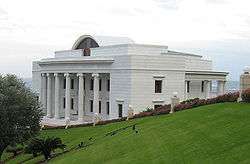Hossein Amanat
Hossein Amanat (Persian: حسین امانت, born 1942[1]) is an Iranian-Canadian architect. He is best known for being the architect of the Shahyad Tower in Tehran, Iran, the Baháʼí Arc buildings in Haifa, Israel and the House of Worship in Samoa. He has also been designated as the architect of the future Shrine of ʻAbdu'l-Bahá.[2]
Hossein Amanat | |
|---|---|
_Tower_-_Tehran_-_Earlier_1970s.jpg) | |
| Born | 1942 (age 77–78) Iran |
| Nationality | Iranian-Canadian |
| Alma mater | University of Tehran |
| Occupation | Architect |
| Practice | Amanat Architect / Arc Design International Corp. |
Practice
As a young graduate from the University of Tehran[1] he won a nationwide competition in 1966 to design the Shahyadd Tower, renamed the Azadi Tower in 1979.[3][4] This first architectural project led to the opportunity to create some of Iran's most distinctive projects with reference to traditional Persian architecture. Amongst them are the initial buildings of the Sharif University of Technology in Tehran, Iran.,[5] the Persian Heritage Center, the Faculty for Business Management of the Tehran University and the Embassy of Iran in Beijing, China. As a member of the persecuted Baháʼí Faith, Amanat fled the country during the 1979 Iranian Revolution.[6] He is the brother of Abbas Amanat, Professor of History & International Studies at Yale University.
Since moving to Canada in 1980, Hossein Amanat designed the three administrative buildings on the Baháʼí Arc in Haifa, Israel, the Baháʼí House of Worship in Samoa,[1][7][8][9] the Jiang'an Library for the Sichuan University, the media library for the Beijing Broadcasting Institute. He designed religious and cultural centers for the Baháʼí Faith near Dallas, Texas, Seattle and Washington, D.C., several multifamily condominiums in Santa Monica, California, and mixed-use high-rise buildings in San Diego, California and Burnaby, British Columbia, Canada.
On 7 May 2019 the Universal House of Justice announced Amanat as the architect of the future Shrine of ʻAbdu'l-Bahá.[2]
Awards
- 2001 American Concrete Institute Award
- 1995 Excellence in Building Design, Marble from Greece Competition
- 1985 Tucker Award for Architectural Excellence
- 1975 Royal Pahlavi Medal for Design
- 1971 Medal of Art - Iranian Ministry of Education

 Centre for the Study of the Sacred Texts
Centre for the Study of the Sacred Texts The Seat of the International Teaching Centre
The Seat of the International Teaching Centre Jiang'an Library at the Sichuan University, China
Jiang'an Library at the Sichuan University, China Horizon residential Towers, San Diego, California
Horizon residential Towers, San Diego, California Bayside residential Tower, San Diego, California
Bayside residential Tower, San Diego, California
See also
- List of historical Iranian architects
References
- Baháʼí community of Canada. "Hossein Amanat". Archived from the original on Oct 2007. Retrieved 2007-04-29.
- "7 May 2019 – To all National Spiritual Assemblies | Baháʼí Reference Library". www.bahai.org. Retrieved 2019-05-07.
- Hossein Amanat's official website. "Shahyad Monument". Archived from the original on 2008-09-14. Retrieved 2007-04-29.
- "The man behind Iran's most famous tower". BBC News. Retrieved 2016-01-14.
- Hossein Amanat's official website. "Aryamehr University". Archived from the original on 2008-11-19. Retrieved 2007-04-29.
- "Tehran's Azadi Tower, witness to history, victim of neglect". Reuters. 20 February 2013.
- "Royal welcome at jubilee gathering in Samoa". Baháʼí World News Service. 2004-11-30. Retrieved 2008-01-05.
- Todd, Douglas (2001-05-21). "2 B.C. architects designed new world centre for Baha'i faith". Vancouver Sun. Archived from the original on 2007-10-20. Retrieved 2008-01-06.
- "Northern Virginia Baháʼí Center Opens Its Door". 2007-08-23. Retrieved 2008-01-06.
External links
| Wikimedia Commons has media related to Hossein Amanat. |
- Amanat Architect
- (in Persian) BBC interview with Hossein Amanat, October 2007
- A list of Canadian Baháʼís in the news
- BBC interview: The man behind Tehran's Freedom Monument July 2009